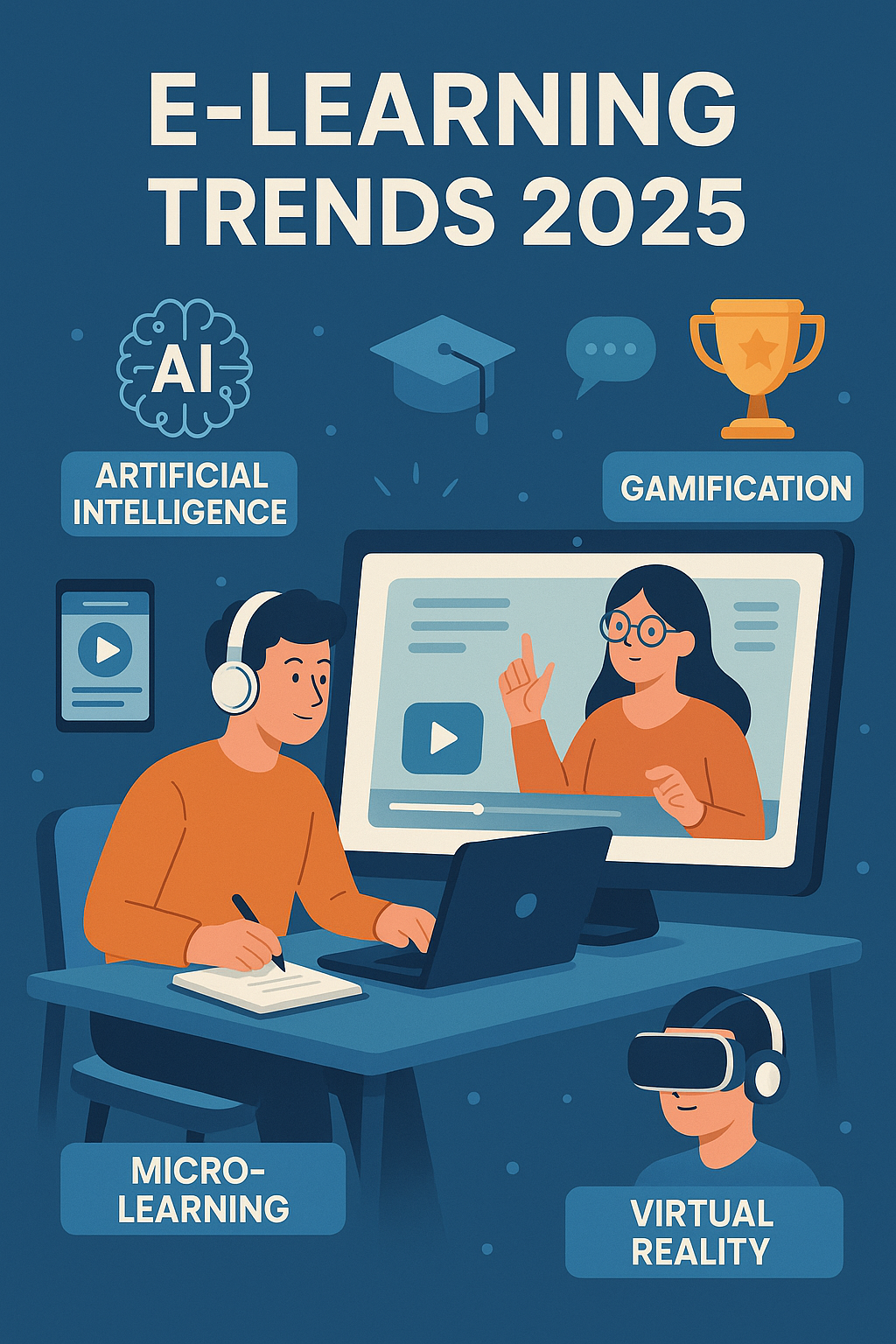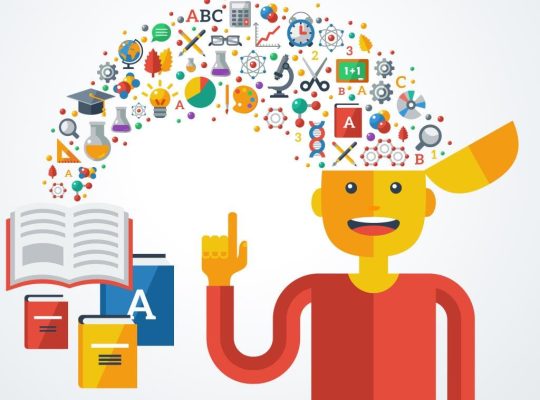As we look ahead to 2025, the landscape of education is poised for a remarkable transformation, driven by the rapid advancements in e-learning technology. The way we learn, teach, and engage with educational content is evolving, with innovative trends that promise to redefine the learning experience for students of all ages. From the rise of artificial intelligence tailoring personalized learning pathways to immersive virtual reality classrooms making subjects come alive, these trends are not just enhancements—they’re game-changers. As educators, institutions, and learners embrace these developments, the question arises: how will these changes shape the future of education in a digital age? Join us as we explore the top e-learning trends to watch in 2025, unveiling the exciting possibilities that lie ahead and how they could revolutionize how we think about learning and teaching.
The Rise of Artificial Intelligence in E-Learning
Artificial intelligence (AI) is making significant inroads into the realm of e-learning, promising to revolutionize how educational content is delivered and consumed. One of the most notable impacts of AI is its ability to create personalized learning experiences. By analyzing vast amounts of data on students’ learning patterns, AI can tailor educational materials to meet individual needs, ensuring that each student receives a unique and optimized learning journey. The days of the one-size-fits-all approach to education are swiftly becoming a thing of the past, as AI enables more adaptive and responsive learning environments.
In addition to personalized learning, AI can also significantly enhance the efficiency of administrative tasks in education. For instance, AI-driven chatbots can handle routine inquiries from students, freeing up educators’ time and allowing them to focus more on teaching and mentoring. These chatbots can provide instant responses to questions about course content, deadlines, or technical issues, ensuring that students receive timely support without having to wait for human intervention. This increased efficiency can lead to a more seamless and engaging educational experience for learners.
Moreover, AI’s role in e-learning is not limited to just personalization and administrative support; it also extends to the realm of content creation and delivery. AI algorithms can analyze existing educational content and suggest improvements, identify gaps, and even generate new materials. This capability can be particularly beneficial in creating adaptive assessments that adjust in real-time based on a student’s performance, providing immediate feedback and fostering a more dynamic learning process. As AI continues to evolve, its impact on e-learning is expected to grow, making education more accessible, efficient, and tailored to individual needs.
Personalized Learning Experiences
The concept of personalized learning is gaining traction, and with good reason. Traditional education systems often struggle to cater to the diverse needs of students, leading to varying levels of engagement and achievement. Personalized learning aims to address this issue by leveraging technology to create customized educational experiences that cater to each learner’s unique strengths, weaknesses, and preferences. This approach not only enhances student engagement but also promotes deeper understanding and retention of knowledge.
One of the key components of personalized learning is the use of adaptive learning technologies. These technologies employ sophisticated algorithms to analyze students’ interactions with educational content and adjust the learning pathway accordingly. For example, if a student is struggling with a particular concept, the system can provide additional resources, exercises, and explanations to help them grasp the material. Conversely, if a student demonstrates proficiency in a topic, the system can accelerate their progress, presenting more advanced content to keep them challenged and motivated.
Another important aspect of personalized learning is the integration of student choice and voice in the educational process. By allowing students to have a say in what, how, and when they learn, personalized learning empowers them to take ownership of their education. This sense of agency can lead to increased motivation and a more meaningful learning experience. Technology plays a crucial role in facilitating this approach, providing tools and platforms that enable students to access diverse resources, set their own learning goals, and track their progress. As personalized learning continues to evolve, it holds the potential to transform education by making it more student-centered, engaging, and effective.
The Role of Gamification in Education
Gamification, the application of game design elements in non-game contexts, has emerged as a powerful tool in the field of education. By incorporating elements such as points, badges, leaderboards, and challenges into the learning process, gamification can make education more engaging and enjoyable for students. This approach leverages the natural human inclination for competition, achievement, and reward, creating a more dynamic and interactive learning environment.
One of the primary benefits of gamification is its ability to increase student motivation and engagement. Traditional educational methods can sometimes be perceived as monotonous or disconnected from real-world applications. Gamification addresses this issue by introducing elements of fun and excitement, making learning more appealing and relevant. When students are actively engaged and motivated, they are more likely to retain information, participate in class activities, and achieve better academic outcomes.
Moreover, gamification can foster a sense of community and collaboration among students. Many gamified learning platforms include features that encourage teamwork and social interaction, such as multiplayer challenges, group projects, and peer feedback. These elements not only enhance the learning experience but also help students develop important social and collaborative skills. By creating a supportive and interactive learning environment, gamification can contribute to a more holistic and well-rounded education.
Mobile Learning: Learning on the Go
The proliferation of smartphones and tablets has paved the way for mobile learning, or m-learning, which allows students to access educational content anytime, anywhere. This trend is particularly significant in today’s fast-paced world, where flexibility and convenience are highly valued. Mobile learning enables students to learn on the go, making education more accessible and accommodating to diverse lifestyles and schedules.
One of the key advantages of mobile learning is its ability to provide just-in-time learning opportunities. With mobile devices, students can quickly access educational resources, videos, and tutorials whenever they encounter a question or need clarification on a topic. This immediacy can enhance the learning process by providing timely support and reinforcing concepts through real-world applications. Additionally, mobile learning can facilitate continuous learning, allowing students to engage with educational content outside of traditional classroom settings.
Another important aspect of mobile learning is its potential to bridge the digital divide and promote educational equity. By providing access to high-quality educational resources through mobile devices, m-learning can reach underserved and remote communities that may lack access to traditional educational institutions. This democratization of education can help level the playing field, offering opportunities for lifelong learning and skill development to individuals from diverse backgrounds. As mobile learning continues to evolve, it holds the promise of making education more inclusive, flexible, and responsive to the needs of learners in the digital age.
Virtual and Augmented Reality in E-Learning
Virtual reality (VR) and augmented reality (AR) are set to revolutionize the e-learning landscape by offering immersive and interactive learning experiences. These technologies have the potential to transform how educational content is delivered, making it more engaging, realistic, and impactful. By creating virtual environments and overlaying digital information onto the real world, VR and AR can bring subjects to life, providing students with hands-on experiences that are not possible through traditional methods.
One of the most significant advantages of VR and AR in education is their ability to create immersive learning experiences. For example, students can explore historical events, visit distant planets, or conduct complex scientific experiments in a virtual environment. These experiences can enhance understanding and retention by providing a multisensory approach to learning. By engaging multiple senses and creating a sense of presence, VR and AR can make abstract concepts more concrete and relatable.
In addition to enhancing comprehension, VR and AR can also foster collaboration and creativity among students. Many VR and AR applications are designed to support group activities and collaborative projects, allowing students to work together in virtual environments. This can help develop important skills such as teamwork, communication, and problem-solving. Furthermore, these technologies can encourage creativity by providing students with tools to create their own virtual worlds, simulations, and interactive experiences. As VR and AR continue to advance, their impact on e-learning is expected to grow, offering new and exciting possibilities for education.
The Importance of Microlearning
Microlearning, the practice of delivering educational content in small, manageable chunks, is gaining popularity as an effective and efficient approach to learning. This trend is driven by the recognition that traditional long-form content can be overwhelming and difficult to retain, especially in an era of information overload. Microlearning addresses this challenge by breaking down complex topics into bite-sized lessons, making it easier for students to absorb and retain information.
One of the key benefits of microlearning is its alignment with the principles of cognitive psychology. Research has shown that the human brain is better suited to processing and retaining information when it is presented in small, focused segments. By delivering content in short bursts, microlearning reduces cognitive load and enhances memory retention. This approach is particularly effective for busy learners who may have limited time and attention spans, allowing them to engage with educational content in a more manageable and sustainable way.
Another advantage of microlearning is its flexibility and adaptability. Microlearning modules can be easily integrated into various learning environments, whether in formal educational settings, corporate training programs, or self-directed learning. These modules can be accessed on-demand, allowing learners to study at their own pace and revisit content as needed. Additionally, microlearning is well-suited to mobile learning platforms, enabling students to access short lessons on their smartphones or tablets while on the go. As microlearning continues to evolve, it holds the potential to make education more accessible, efficient, and aligned with the needs and preferences of modern learners.
Social Learning and Collaborative Platforms
Social learning, the process of learning through observation, imitation, and interaction with others, is becoming increasingly important in the digital age. Collaborative platforms and social media tools are facilitating this trend by providing students with opportunities to connect, share, and learn from their peers. These platforms are transforming education from a solitary activity into a more interactive and communal experience, fostering a sense of community and collaboration among learners.
One of the primary benefits of social learning is its ability to enhance student engagement and motivation. Learning in isolation can be challenging and demotivating, but when students have the opportunity to collaborate with their peers, they are more likely to stay engaged and motivated. Social learning platforms enable students to participate in discussions, share insights, and provide feedback, creating a dynamic and interactive learning environment. This sense of community can lead to increased accountability and a deeper commitment to the learning process.
In addition to fostering engagement, social learning can also promote the development of important social and cognitive skills. Through collaborative activities, students can practice communication, teamwork, and problem-solving, which are essential skills for success in the modern workforce. Social learning platforms also provide opportunities for peer-to-peer teaching and mentoring, allowing students to learn from each other’s experiences and perspectives. By leveraging the power of social interaction, these platforms can create a more holistic and enriching educational experience.
Data Analytics in E-Learning: Enhancing Outcomes
Data analytics is playing an increasingly important role in e-learning, offering valuable insights that can enhance educational outcomes. By collecting and analyzing data on student performance, engagement, and behavior, educators can make more informed decisions about curriculum design, instructional strategies, and resource allocation. This data-driven approach can lead to more effective and personalized learning experiences, ultimately improving student achievement and satisfaction.
One of the key benefits of data analytics in education is its ability to identify patterns and trends that may not be immediately apparent. For example, data analytics can reveal which topics students are struggling with, which resources are most effective, and how different teaching methods impact learning outcomes. By identifying these patterns, educators can make targeted interventions to address gaps in knowledge, provide additional support, and optimize the learning process. This proactive approach can help ensure that students receive the support they need to succeed.
In addition to informing instructional decisions, data analytics can also enhance the student experience by providing real-time feedback and personalized recommendations. Learning analytics platforms can track student progress and provide immediate feedback on performance, helping students identify areas for improvement and stay on track with their learning goals. These platforms can also suggest personalized learning pathways, recommending resources and activities based on individual needs and preferences. By leveraging the power of data, e-learning can become more responsive, adaptive, and aligned with the needs of each learner.
Conclusion: The Future of Education in a Digital World
As we look to the future, it is clear that e-learning will play a pivotal role in shaping the landscape of education. The trends discussed in this article—artificial intelligence, personalized learning, gamification, mobile learning, virtual and augmented reality, microlearning, social learning, and data analytics—are not just enhancements to traditional education; they are transformative forces that have the potential to redefine how we think about teaching and learning. These innovations are making education more accessible, engaging, and effective, paving the way for a more inclusive and dynamic learning environment.
The integration of these trends into the educational system will require collaboration and commitment from all stakeholders, including educators, institutions, policymakers, and technology providers. By embracing these advancements and working together to address the challenges and opportunities they present, we can create a more equitable and future-ready education system. This will involve rethinking traditional models of education, investing in professional development for educators, and ensuring that all students have access to the tools and resources they need to succeed.
Ultimately, the future of education lies in our ability to harness the power of technology to create meaningful and impactful learning experiences. As we continue to explore and innovate, we must remain focused on the needs and aspirations of learners, ensuring that education remains a transformative force for personal and societal growth. The e-learning trends of 2025 offer a glimpse into a future where education is more personalized, interactive, and connected than ever before, and it is up to us to seize these opportunities and shape the future of education in a digital world.



